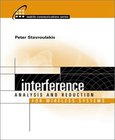Circuits and Systems for Wireless Communications

Book Details:
| Publisher: | Springer |
| Series: | Springer |
| Author: | Markus Helfenstein |
| Edition: | 1 |
| ISBN-10: | 0792377222 |
| ISBN-13: | 9780792377221 |
| Pages: | 404 |
| Published: | Dec 01 1999 |
| Posted: | Nov 19 2014 |
| Language: | English |
| Book format: | |
| Book size: | 9.53 MB |
Book Description:
This book contains revised contributions by the speakers of the 1st IEEE Workshop on Wireless Communication Circuits and Systems, held in Lucerne, Switzerland, from June 22-24, 1998. The aim of the workshop was to demonstrate the vast expertise of the CAS Society in the area of circuit and system design to the rapidly growing field of wireless communications. The workshop combined presentations by invited experts from academia and industry with panel and informal discussions. The following topics were covered: RF System Integration (single-chip systems, CMOS RF circuits), RF Front-End Circuits (CMOS RF oscillators, broadband design techniques), Wideband Conversion for Software Radio (A/D conversion issues, wideband sub-sampling, low-spurious A/D conversion), Process Technologies for Future RF Systems (Si, SiGe, GaAs, CMOS, packaging technologies), DSP for Wireless Communications (DSP algorithms, fixed-point systems, DSP for baseband applications), Blind Channel Equalization (adaptive interference suppression, design techniques, channel estimation). A carefully selected combination of tutorial-like papers as well as papers on specialized and advanced topics is included. Thus, newcomers to the field of wireless communications will benefit from the overview of emerging technologies in circuits and systems, and specialists will benefit from the thought-provoking details presented in this book.
Download Link:
Related Books:
TDD-CDMA for Wireless Communications
This resource offers a comprehensive description of TDD-CDMA technology. It presents in-depth coverage of the important TDD-based standards, including the 3GPPs TD-CDMA for UMTS, and TD-SCDMA, the Chinese 3G standard. The authors discuss the differences between the TDD and FDD modes of CDMA, and uncover the advantages of TD-CDMA in 3G systems....
MIMO System Technology for Wireless Communications
For broadband communications, it was frequency division multiplexing. For optical communications, it was wavelength division multiplexing. Then, for all types of networks it was code division. Breakthroughs in transmission speed were made possible by these developments, heralding next-generation networks of increasing capability in each case. The basic idea is the same: more channels equals higher throughput. For wireless communications, it is space-time coding using multiple-input-multiple-output (MIMO) technology.Providing a complete treatment of MIMO under a single cover, MIMO System Technology for Wireless Communications assembles coverage on all aspects of MIMO technology along with up-to-date information on key related issues. Contributors from...
Interference Analysis and Reduction
For Wireless Systems
This resource shows professionals how to analyze interference signals and provides them with modern tools and techniques they can use in real-world applications to help guarantee optimum system performance. Hands-on details are provided to help practitioners categorise and quantify interference agents in communications; identify design parameters of wireless systems which affect and can be affected by interference; design and develop quality metrics of wireless systems in an interference environment; develop new interference suppression and mitigation techniques; and design practical interference cancellers for wireless systems....
2007 - 2021 © eBooks-IT.org



